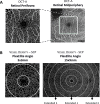Swept-source OCTA quantification of capillary closure predicts ETDRS severity staging of NPDR
- PMID: 33355147
- PMCID: PMC9046755
- DOI: 10.1136/bjophthalmol-2020-317890
Swept-source OCTA quantification of capillary closure predicts ETDRS severity staging of NPDR
Abstract
Purpose: To test whether a single or composite set of parameters evaluated with optical coherence tomography angiography (OCTA), representing retinal capillary closure, can predict non-proliferative diabetic retinopathy (NPDR) staging according to the gold standard ETDRS grading scheme.
Methods: 105 patients with diabetes, either without retinopathy or with different degrees of retinopathy (NPDR up to ETDRS grade 53), were prospectively evaluated using swept-source OCTA (SS-OCTA, PlexElite, Carl Zeiss Meditec) with 15×9 mm and 3×3 mm angiography protocols. Seven-field photographs of the fundus were obtained for ETDRS staging. Eyes from age-matched healthy subjects were also imaged as control.
Results: In eyes of patients with type 2 diabetes without retinopathy or ETDRS levels 20 and 35, retinal capillary closure was in the macular area, with predominant alterations in the parafoveal retinal circulation (inner ring). Retinal capillary closure in ETDRS stages 43-53 becomes predominant in the retinal midperiphery with vessel density average values of 25.2±7.9 (p=0.001) in ETDRS 43 and 23.5±3.4 (p=0.001) in ETDRS 47-53, when evaluating extended areas of 15×9 protocol. Combination of acquisition protocols 3×3 mm and 15×9 mm, using SS-OCTA, allows discrimination between eyes with mild NPDR (ETDRS 10, 20, 35) and eyes with moderate-to-severe NPDR (ETDRS grades 43-53).
Conclusions: Retinal capillary closure, quantified by SS-OCTA, can identify NPDR severity progression. It is located mainly in the perifoveal retinal capillary circulation in the initial stages of NPDR, whereas the retinal midperiphery is predominantly affected in moderate-to-severe NPDR.
Keywords: diagnostic tests/Investigation; imaging; retina.
© Author(s) (or their employer(s)) 2022. Re-use permitted under CC BY-NC. No commercial re-use. See rights and permissions. Published by BMJ.
Conflict of interest statement
Competing interests: TS, ARS, IPM, LGM and MHM do not have financial disclosures. LHW, SK, LdS and MD: Carl Zeiss Meditec (E). JGC-V reports grants from Carl Zeiss Meditec and is consultant for Alimera Sciences, Allergan, Bayer, Gene Signal, Novartis, Pfizer, Precision Ocular, Roche, Sanofi-Aventis, Vifor Pharma, and Carl Zeiss Meditec.
Figures
Similar articles
-
Patterns of Progression of Nonproliferative Diabetic Retinopathy Using Non-Invasive Imaging.Transl Vis Sci Technol. 2024 May 1;13(5):22. doi: 10.1167/tvst.13.5.22. Transl Vis Sci Technol. 2024. PMID: 38780953 Free PMC article.
-
Interaction Between the Distribution of Diabetic Retinopathy Lesions and the Association of Optical Coherence Tomography Angiography Scans With Diabetic Retinopathy Severity.JAMA Ophthalmol. 2020 Dec 1;138(12):1291-1297. doi: 10.1001/jamaophthalmol.2020.4516. JAMA Ophthalmol. 2020. PMID: 33119083 Free PMC article.
-
Macular OCT-angiography parameters to predict the clinical stage of nonproliferative diabetic retinopathy: an exploratory analysis.Eye (Lond). 2019 Aug;33(8):1240-1247. doi: 10.1038/s41433-019-0401-7. Epub 2019 Mar 22. Eye (Lond). 2019. PMID: 30903092 Free PMC article.
-
Optical coherence tomography angiography and microvascular changes in diabetic retinopathy: a systematic review.Acta Ophthalmol. 2019 Feb;97(1):7-14. doi: 10.1111/aos.13859. Epub 2018 Sep 20. Acta Ophthalmol. 2019. PMID: 30238633
-
Early Detection of Microvascular Impairments With Optical Coherence Tomography Angiography in Diabetic Patients Without Clinical Retinopathy: A Meta-analysis.Am J Ophthalmol. 2021 Feb;222:226-237. doi: 10.1016/j.ajo.2020.09.032. Epub 2020 Sep 22. Am J Ophthalmol. 2021. PMID: 32976846
Cited by
-
Looking Ahead: Visual and Anatomical Endpoints in Future Trials of Diabetic Macular Ischemia.Ophthalmologica. 2021;244(5):451-464. doi: 10.1159/000515406. Epub 2021 Feb 24. Ophthalmologica. 2021. PMID: 33626529 Free PMC article. Review.
-
A Central Role for Ischemia and OCTA Metrics to Follow DR Progression.J Clin Med. 2021 Apr 22;10(9):1821. doi: 10.3390/jcm10091821. J Clin Med. 2021. PMID: 33922018 Free PMC article.
-
Characterization of One-Year Progression of Risk Phenotypes of Diabetic Retinopathy.Ophthalmol Ther. 2022 Feb;11(1):333-345. doi: 10.1007/s40123-021-00437-z. Epub 2021 Dec 5. Ophthalmol Ther. 2022. PMID: 34865186 Free PMC article.
-
Patterns of Progression of Nonproliferative Diabetic Retinopathy Using Non-Invasive Imaging.Transl Vis Sci Technol. 2024 May 1;13(5):22. doi: 10.1167/tvst.13.5.22. Transl Vis Sci Technol. 2024. PMID: 38780953 Free PMC article.
-
Perspectives of diabetic retinopathy-challenges and opportunities.Eye (Lond). 2023 Aug;37(11):2183-2191. doi: 10.1038/s41433-022-02335-5. Epub 2022 Dec 9. Eye (Lond). 2023. PMID: 36494431 Free PMC article. Review.
References
Publication types
MeSH terms
LinkOut - more resources
Full Text Sources
Other Literature Sources
Medical

